
Analysis: Trump election win could add 4bn tonnes to US emissions by 2030
Multiple Authors
03.06.24Multiple Authors
06.03.2024 | 1:45pmA victory for Donald Trump in November’s presidential election could lead to an additional 4bn tonnes of US emissions by 2030 compared with Joe Biden’s plans, Carbon Brief analysis reveals.
This extra 4bn tonnes of carbon dioxide equivalent (GtCO2e) by 2030 would cause global climate damages worth more than $900bn, based on the latest US government valuations.
For context, 4GtCO2e is equivalent to the combined annual emissions of the EU and Japan, or the combined annual total of the world’s 140 lowest-emitting countries.
Put another way, the extra 4GtCO2e from a second Trump term would negate – twice over – all of the savings from deploying wind, solar and other clean technologies around the world over the past five years.
If Trump secures a second term, the US would also very likely miss its global climate pledge by a wide margin, with emissions only falling to 28% below 2005 levels by 2030. The US’s current target under the Paris Agreement is to achieve a 50-52% reduction by 2030.
Carbon Brief’s analysis is based on an aggregation of modelling by various US research groups. It highlights the significant impact of the Biden administration’s climate policies. This includes the Inflation Reduction Act – which Trump has pledged to reverse – along with several other policies.
The findings are subject to uncertainty around economic growth, fuel and technology prices, the market response to incentives and the extent to which Trump is able to roll back Biden’s policies.
The analysis might overstate the impact Trump could have on US emissions, if some of Biden’s policies prove hard to unpick – or if subnational climate action accelerates.
Equally, it might understate Trump’s impact. For example, his pledge to “drill, baby, drill” is not included within the analysis and would likely raise US and global emissions further through the increased extraction and burning of oil, gas and coal.
Also not included are the potential for Biden to add new climate policies if he wins a second term, nor the risk that some of his policies will be weakened, delayed or hit by legal challenges.
Regardless of the precise impact, a second Trump term that successfully dismantles Biden’s climate legacy would likely end any global hopes of keeping global warming below 1.5C.
- The ‘Trump effect’ on US emissions
- How the Biden administration is tackling warming
- What a second-term Trump might do
- The global climate implications of the US election
- How the analysis was carried out
The ‘Trump effect’ on US emissions
US greenhouse gas emissions have been falling steadily since 2005, due to a combination of economic shifts, greater efficiency, the growth of renewables and a shift from coal to gas power.
Since taking office in early 2021, Biden has pledged under the Paris Agreement to accelerate that trend by cutting US emissions to 50-52% below 2005 levels in 2030 and to net-zero in 2050.
He has implemented a long list of policies – most notably the 2022 Inflation Reduction Act – to keep those targets within reach. (See: How the Biden administration is tackling warming.)
In the “Biden” scenario in the figure below (blue line), all federal climate policies currently in place or in the process of being finalised are assumed to continue. The scenario does not include any new climate policies that might be adopted after November’s election.
The administration’s current climate policies are expected to cut US emissions significantly, bringing the country close to meeting its 2030 target range. Nevertheless, a gap remains between projected emissions and those needed to meet the 2030 and 2050 targets (green).
The “Trump” scenario (red line) assumes the IRA and other key Biden administration climate policies are rolled back. It does not include further measures that Trump could take to boost fossil fuels or undermine the progress of clean energy. (See: What a second-term Trump might do.)
For both projections, the shaded area shows the range of results from six different models, with varying assumptions on economic growth, fuel costs and the price of low-carbon technologies.
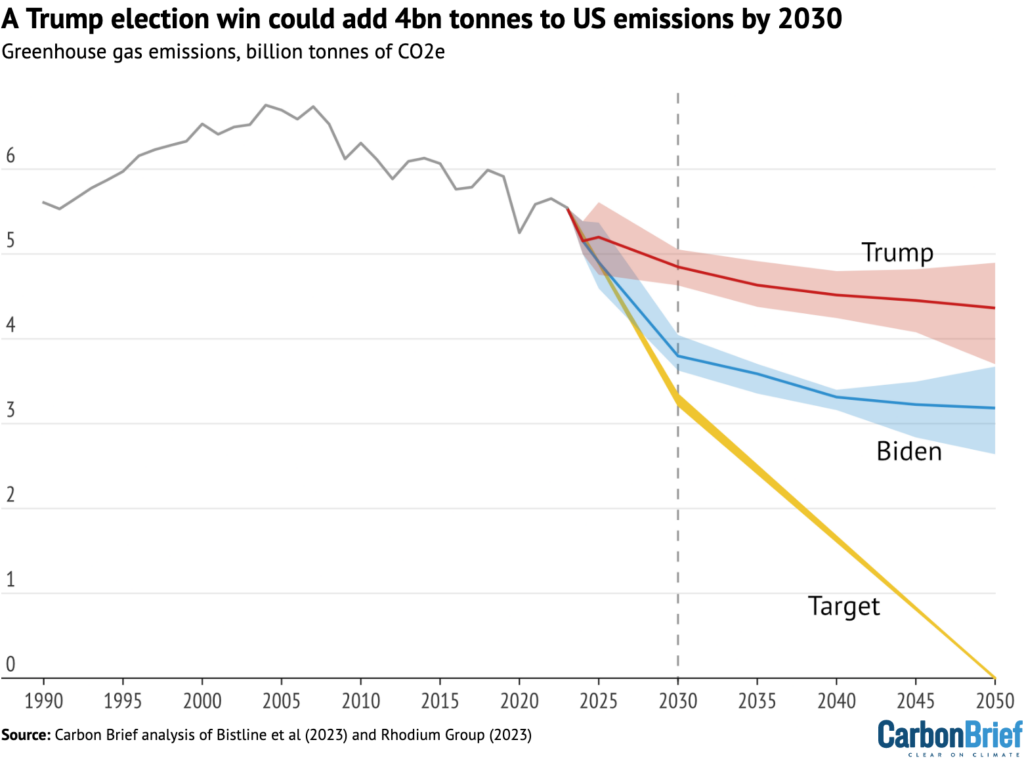
In total, the analysis suggests that US greenhouse gas emissions would fall to 28% below 2005 levels by 2030 if Trump secures a second term and rolls back Biden’s policies – far short of the 50-52% target. If Biden is reelected, emissions would fall to around 43% below 2005 levels.
In the Trump scenario, annual US greenhouse gas emissions would be around 1GtCO2e higher in 2030 than under Biden, resulting in a cumulative addition of around 4GtCO2e by that year.
Based on the recently updated central estimate of the social cost of carbon from the US Environmental Protection Agency (US EPA) – which stands at some $230 per tonne of CO2 in 2030 – those 4GtCO2e of extra emissions would cause global climate damages worth more $900bn.
To put the additional emissions in context, EU greenhouse gas emissions currently stand at around 3GtCO2e per year, while Japan’s are another 1GtCO2e. If the EU meets its climate goals, then its emissions would fall to 2GtCO2e in 2030 and to below 1GtCO2e in 2040.
Only eight of the world’s nearly 200 countries have emissions that exceed 1GtCO2e per year – and 4GtCO2e is more than the combined yearly total from the 140 lowest-emitting nations.
Expressed another way, the extra 4GtCO2e would be equivalent to double all of the emissions savings secured globally, over the past five years, by deploying wind, solar, electric vehicles, nuclear and heat pumps.
Carbon Brief’s analysis highlights several key points.
First, that Biden’s climate goals for the US in 2030 and 2050 will not be met, without further policy measures after the next election.
This could include additional state-level action, which could yield an additional 4 percentage points of emissions savings by 2030. Added to the “Biden” pathway, this would take US emissions to 47% below 2005 levels – closer to, but still not in line with the 2030 pledge.
Second, despite this policy gap, Biden’s current climate policies go a significant way towards meeting the 2030 target and could be added to in the future.
Third, if Trump is able to remove all of Biden’s key climate policies, then the US is all but guaranteed to miss its targets by a wide margin.
Given the scale of US emissions and its influence on the world, this makes the election crucial to hopes of limiting warming to 1.5C. (See: The global climate implications of the US election.)
Finally, there is policy uncertainty around which policies will be finalised, how strong any final rules will be, what legal challenges they may face and how easy they prove to roll back.
There is also uncertainty – illustrated by the ranges in the chart – around the impact of Biden’s policies, the response of households, business and industry to those measures, and the rate of economic growth, as well as over future prices for fossil fuels and low-carbon technologies.
These uncertainties are partly – but not entirely – captured by the six models underlying the analysis, which have different model structures and input assumptions.
How the Biden administration is tackling warming
In 2015, the then-president Barack Obama pledged a 26-28% reduction in US emissions below 2005 levels by 2025 as an intended “nationally determined contribution” (iNDC) to the Paris Agreement.
On taking office in 2017, the climate-sceptic president Trump then pulled the US out of the Paris Agreement, attracting global opprobrium. He then rolled back or replaced Obama-era climate policies, including the Clean Power Plan, while attempting – unsuccessfully – to prop up coal.
Trump’s successor as president, Joe Biden, campaigned in 2020 on a platform of a “clean energy revolution”. On gaining office in 2021, he immediately rejoined the Paris Agreement and then issued a more ambitious pledge to cut US emissions to 50-52% below 2005 levels by 2030.
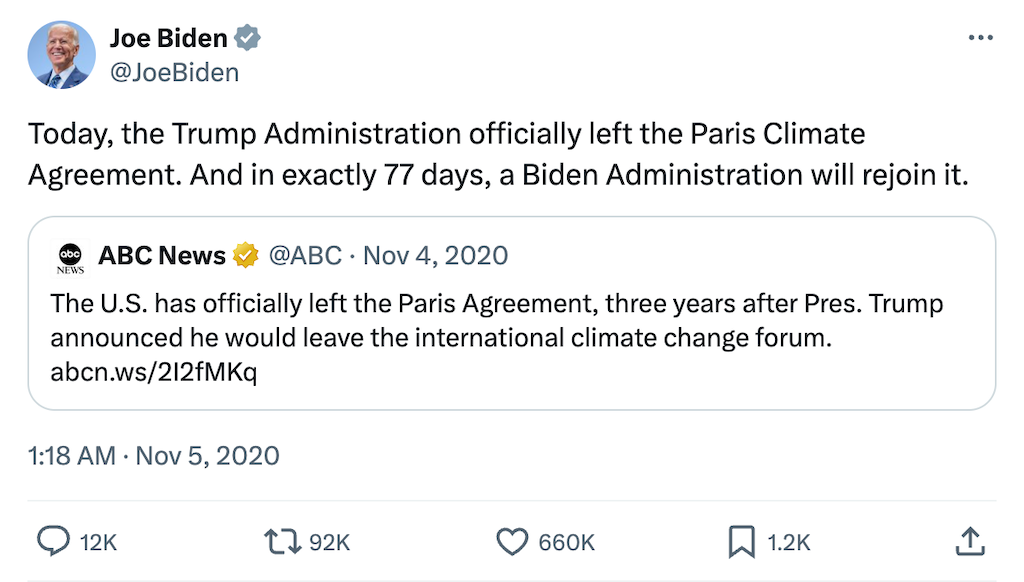
Biden also pledged to decarbonise the electricity grid by 2035 and joined roughly 150 other countries in committing the US to reaching net-zero emissions by 2050 – the global benchmark, if the world is to keep warming below 1.5C.
In order to keep these targets within reach, the Biden administration has ushered in a series of climate policies. Most notable is the 2022 IRA, unexpectedly passed by Congress after a 51-50 Senate vote, with the tie broken by the vice president Kamala Harris.
This has been called the largest package of domestic climate measures in US history. It offers incentives covering a broad swathe of the economy from low-carbon manufacturing to clean energy, electric vehicles, “climate-smart” agriculture and low-carbon hydrogen.
The IRA accounts for the most significant part of the emissions reductions expected as a result of Biden’s climate policies to date and shown by the blue line in the figure above.
It includes grants, loans and tax credits initially estimated to be worth $369bn. However, most of the tax credits are not capped, meaning the overall cost and impact on emissions is uncertain.
In general, cost estimates have risen since its passing, as investments triggered by the bill’s incentives have rolled in, with some now putting its ultimate cost above $1tn.
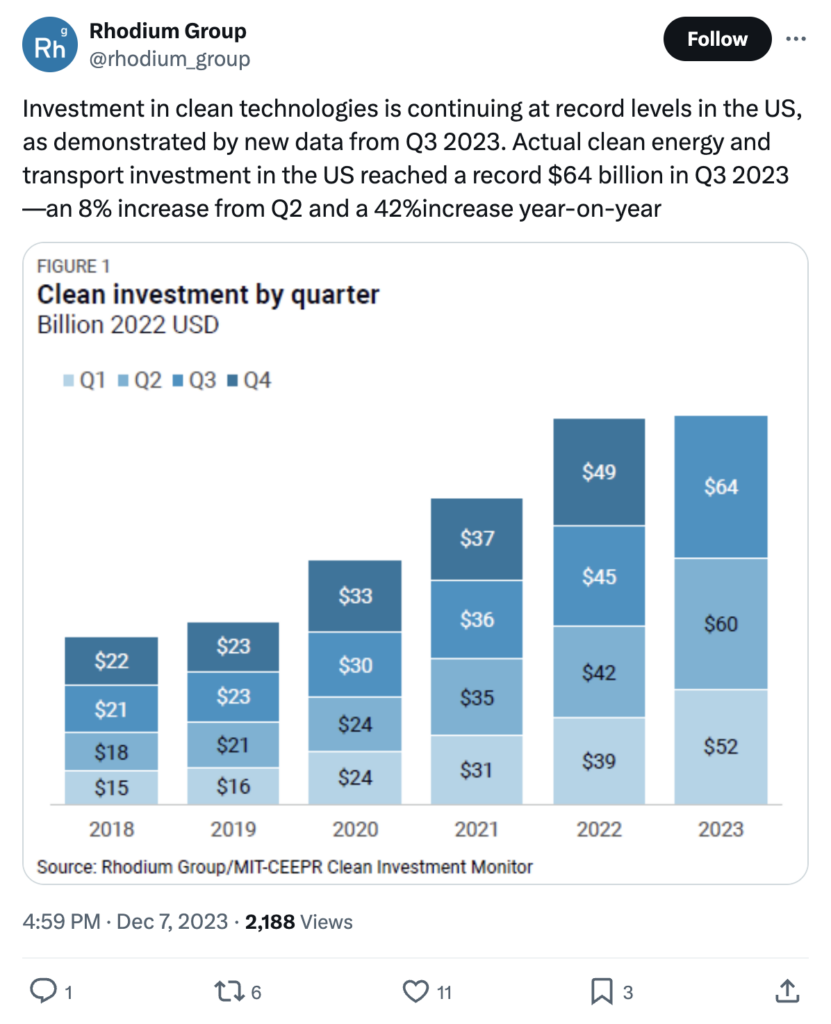
However, a recent analysis of progress since the bill passed in 2021 shows that while electric vehicle sales are running at the top end of what was expected in earlier modelling of the IRA’s impact, the deployment of clean electricity – in particular, wind power – is falling slightly behind.
(Another recent study looks at the behavioural challenges that could affect the success or failure of the IRA, including as a result of political polarisation. Separately, gas power expansion plans from several major US utilities also pose a challenge to the IRA.)
Other Biden administration initiatives with important implications for US emissions include the 2021 Infrastructure Investment and Jobs Act, loans for nuclear power plants and new standards on appliance efficiency issued by the Department of Energy.
Meanwhile, the US Environmental Protection Agency (US EPA) has finalised rules on methane emissions from oil and gas facilities. It has also proposed – but not yet finalised – rules on vehicle fuel standards, power plant greenhouse gas standards and power plant air pollution.
The administration is now rushing to finalise these rules within the next couple of months, so that they could not be overturned easily after the election using the Congressional Review Act.
The administration is reportedly planning to weaken its proposed vehicle fuel standards. The final version would retain the original aim of having two-thirds of new sales be all-electric by 2032, but would ease the trajectory to reaching that target, according to the New York Times. This would reduce the emissions-cutting impact, relative to what is assumed in the “Biden” scenario.
Separately, the administration is reported to be exempting existing gas-fired units from its proposed power plant emissions rules, focusing for now on existing coal and future gas-fired units. The New York Times quotes EPA administrator Michael Regan saying this will “achieve greater emissions reductions”, but the timescales could also affect the scenario projection.
Meanwhile, Biden has also overseen a rare Senate approval of an international climate treaty, when it ratified the Kigali Amendment on tackling climate-warming hydrofluorocarbons in 2022, with the US EPA issuing related rules the following year.
In addition, Biden’s time in office has seen further state-level action on emissions. This includes California’s clean car standards, as strengthened in 2022 and adopted by six other states.
What a second-term Trump might do
For his part, former president and Republican front-runner Donald Trump has made no secret of his desire to roll back his predecessor’s climate policies, just as he did during his first term.
For example, in 2018, the Trump administration lifted Obama-era rules on toxic air pollution from electricity generating and industrial sites – with Biden now moving to reverse the reversal.
Similarly, in 2020, his administration rolled back an Obama-era EPA rule on methane emissions from the oil and gas industry. The Biden administration’s methane rule could face a similar fate under a second Trump term.
Trump also has form when it comes to energy efficiency regulations, which he rolled back in 2020.
In November 2023, the Financial Times reported that Trump was “planning to gut” the IRA, increase investment in fossil fuels and roll back regulations to encourage electric vehicles. The newspaper added that Trump had called the IRA the “biggest tax hike in history”.
It quoted Carla Sands, an adviser to Trump, as saying:
“On the first day of a second Trump administration, the president has committed to rolling back every single one of Joe Biden’s job-killing, industry-killing regulations.”
Indeed, Republicans in the US House of Representatives have already made multiple attempts to repeal parts of the IRA. While some analysts think a full repeal of the act is unlikely, it is clear that a second-term Trump could – as Politico put it – ”hobble the climate law”.
A February 2024 commentary from investment firm Trium Capital argues that the impact on IRA will depend not only on whether Trump wins victory in November, but also on whether the Republicans retain control of the House and gain a Senate majority.
Even if the Republicans win all three races, the commentary suggests that some parts of IRA might survive beyond the election. It says that consumer incentives for electric vehicles and home heating are “most at risk”, whereas tax credits for clean energy might only be modified.
Equally, MIT Technology Review says that clean energy and EV tax credits both “appear especially vulnerable, climate policy experts say”. The publication adds:
“Moreover, Trump’s wide-ranging pledges to weaken international institutions, inflame global trade wars, and throw open the nation’s resources to fossil-fuel extraction could have compounding effects on any changes to the IRA, potentially undermining economic growth, the broader investment climate, and prospects for emerging green industries.”
Meanwhile, Trump has also criticised Biden’s infrastructure act and previously revoked California’s ability to set tougher car emissions standards, which are also adopted by other states.
In 2022, the California “waiver” was reinstated by Biden, who also opposed a 2023 Republican bill designed to remove California’s right to regulate. Yet the waiver is now embroiled in legal action brought by Republican states, expected to end up in the Supreme Court.
If he emerges victorious in November, Trump would also “plan to destroy the EPA”, according to a Guardian article published earlier this month. It reported:
“Donald Trump and his advisers have made campaign promises to toss crucial environmental regulations and boost the planet-heating fossil fuel sector. Those plans include systematically dismantling the Environmental Protection Agency (EPA), the federal body with the most power to take on the climate emergency and environmental justice, an array of Trump advisers and allies said.”
The paper cites Project 2025, described as “a presidential agenda put forth by the Heritage Foundation and other conservative organisations”. It also quotes Mandy Gunasekara, Trump’s EPA chief of staff and a contributor to the Project 2025 agenda.
After Trump was elected for the first time, many scientists, politicians and campaigners argued that his presidency would only have a relatively short-term effect on emissions and climate goals.
Many of his first-term efforts to rollback climate rules and boost fossil fuels ended in failure.
While some modelling suggested that his first presidency would delay hitting global emissions targets by a decade, Carbon Brief analysis found that US states and cities might be able to take sufficient steps to meet the country’s then-current climate goal without federal action.
However, another recent Guardian article says that a second-term Trump would be “even more extreme for the environment than his first, according to interviews with multiple Trump allies and advisers”. It adds:
“In contrast to a sometimes chaotic first White House term, they outlined a far more methodical second presidency: driving forward fossil fuel production, sidelining mainstream climate scientists and overturning rules that curb planet-heating emissions.”
Carbon Brief’s “Trump” scenario does not include additional fossil fuel emissions as a result of policies supporting coal, oil and gas production or use, as the success or otherwise of any such efforts are highly uncertain.
In addition, higher US fossil fuel production would not all be consumed domestically and would not increase global demand on a one-for-one basis.
While it would be likely to raise demand and emissions, both domestically and internationally, the precise impact would depend on the response of markets and overseas policymakers.
The global climate implications of the US election
If Biden – or another Democrat – wins the election in November and if his party regains control over the House and Senate, then they could push to implement new climate policies in 2025.
There is a clear need for further policy, if US climate goals are to be met. Moreover, the expiration of a large number of tax cuts at the end of 2025 could present an opportunity to deploy carbon pricing in support of raising revenues – and cutting emissions – according to a recent study.
It suggests that a price on emissions, described as a “carbon fee”, could significantly boost US chances of hitting its 2030 target, even if paired with a partial repeal of the IRA.
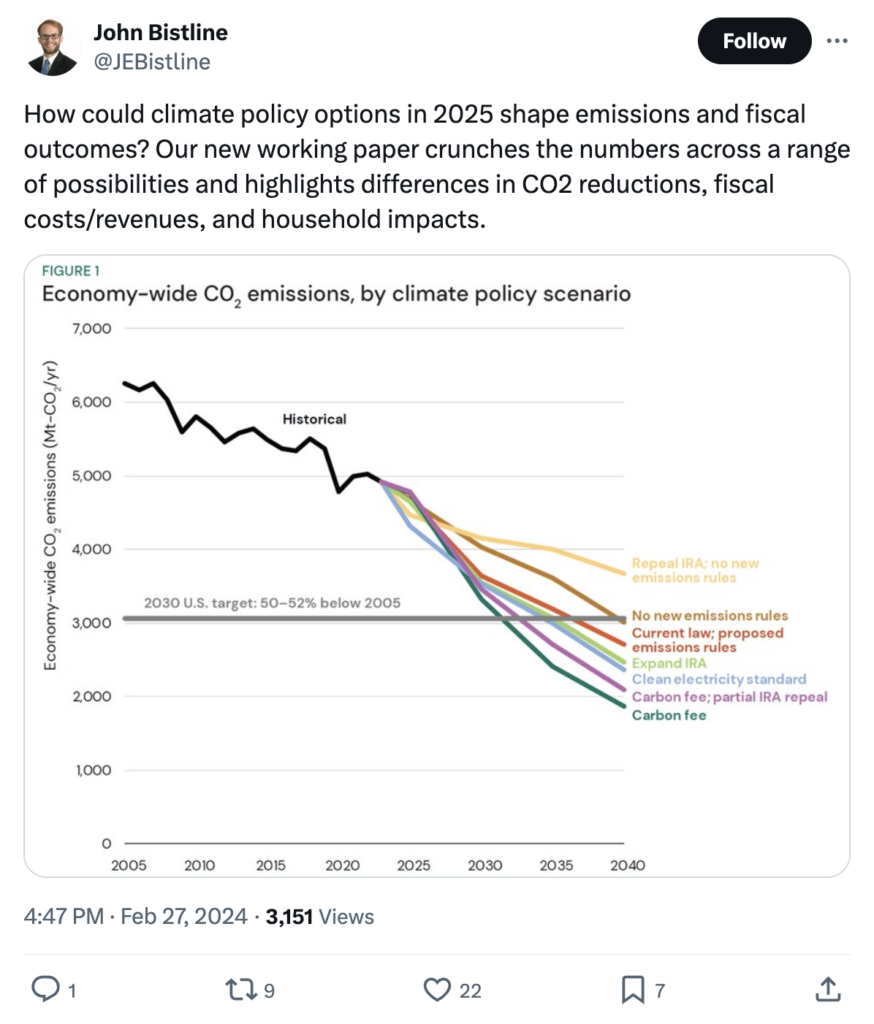
(Note that the “Repeal IRA; no new emissions rules” scenario in this study is similar to the “Trump” scenario in Carbon Brief’s analysis. However, the model used in the study finds a relatively weak 2030 emissions impact of the IRA compared with most of the five others, with which it is aggregated by Carbon Brief.)
An additional point of leverage is the EU’s carbon border adjustment mechanism (CBAM), which will put a carbon price on US exports unless they face an equivalent price domestically, according to Democratic senator Sheldon Whitehouse, speaking at a launch event for the study:
“The 2025 opportunity when the Trump tax cuts collapse [creates] huge room for negotiation. Then you’ve got the CBAM happening in Europe that puts enormous pressure to get a price of carbon, if you want to avoid being tariffed at the EU and UK level.”
Whether a second-term Biden administration would attempt to put a price on carbon or not, it would be likely to push forward new policies in pursuit of US climate targets.
In contrast, a victory for Donald Trump could be expected, at a minimum, to result in full or partial repeal of the IRA and rollbacks of Biden’s climate rules, including power plants, cars and methane.
This is reflected in Carbon Brief’s “Trump” scenario, which would add a cumulative 4GtCO2e to US emissions by 2030, as shown in the figure below.
Moreover, assuming no further policy changes, this cumulative total would continue to climb beyond 2030, reaching 15GtCO2e by 2040 and a huge 27GtCO2e by 2050.
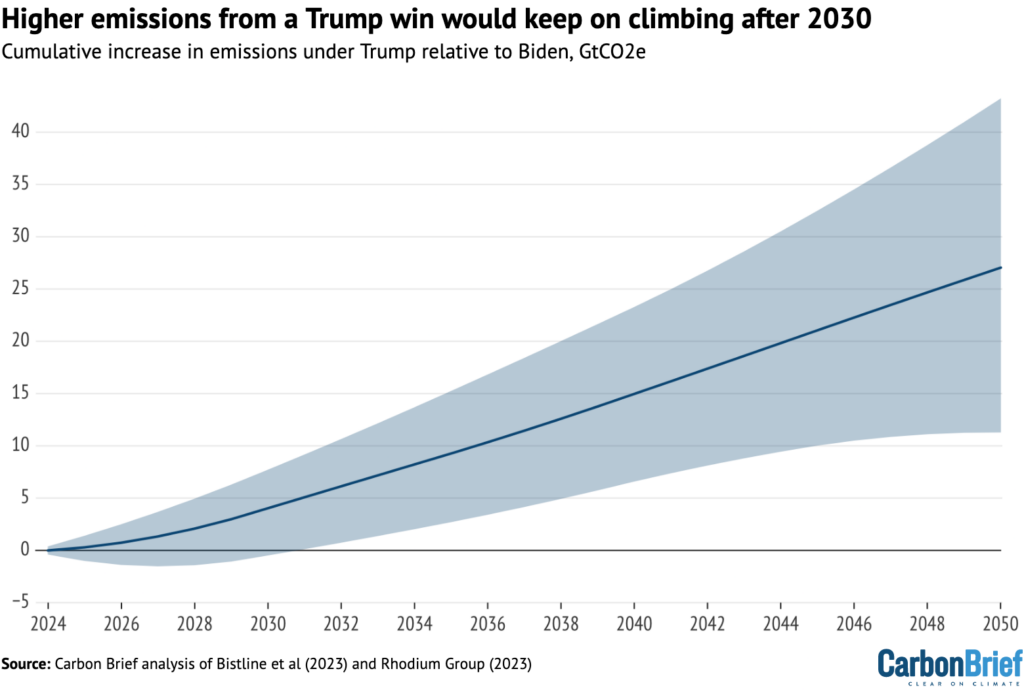
The increases in cumulative emissions under the “Trump” scenario are so large that they would imperil not only the US climate targets, but also global climate goals. (Under the 22nd amendment of the US constitution, Trump would not be allowed to run for a third term.)
In 2022, the Intergovernmental Panel on Climate Change (IPCC) sixth assessment report (AR6) said that it would be “impossible” to stay below 1.5C without strengthening current pledges:
“[F]ollowing current NDCs until 2030…[would make] it impossible to limit warming to 1.5C with no or limited overshoot and strongly increas[e] the challenge to likely limit warming to 2C.”
The corollary of this is that if the US – the world’s second-largest emitter – misses its 2030 target by a wide margin, then it would be likely to end any hope of keeping global warming below 1.5C.
How the analysis was carried out
The two scenarios set out in this analysis are based on an aggregation of modelling published by Bistline et al. (2023) and the Rhodium Group (2023).
The first study was explained by the authors in a Carbon Brief guest post. It compares the impact of the IRA using results from 11 separate models, some of which only cover the power sector. Carbon Brief’s analysis uses results from the six models that cover the entire US economy.
The “Trump” scenario is based on the “reference” pathway in this study, corresponding to the average of the six models. The only modification is that the Trump scenario is set to match the Biden scenario below until 2024.
The “Biden” scenario is based on the average IRA pathway from this study, extended using modelling from the Rhodium Group to include the impact of further Biden administration policies.
Carbon Brief’s analysis uses the “mid-emissions” pathway from the Rhodium study’s “federal-only” scenario, which includes the impact of vehicle fuel standards, power plant greenhouse gas and pollutant emissions rules, and energy efficiency regulations.
This additional Rhodium Group modelling is based on draft rules which have not yet been finalised and are subject to change, as well as to potential legal challenge, as discussed above.
The uncertainty shown for the “Trump” and “Biden” scenarios corresponds to the range in the six economy-wide models from Bistline et al. (2023).
Carbon Brief’s analysis does not include any additional post-2025 climate policies that could be adopted by a second Biden administration. Nor does it include the potential impact of pro-fossil fuel policies that could be introduced by a second Trump administration.
Finally, it also does not include additional subnational climate policies that could be introduced, nor does it consider the risk that current or future state action could be hit by federal or legal challenge.
Historical US greenhouse gas emissions are taken from the US EPA inventory through to 2021. Figures for 2022 and 2023 are based on estimated annual changes from the Rhodium Group.
This article was written by Simon Evans and edited by Leo Hickman. Data analysis was carried out by Verner Viisainen. Visuals by Tom Pearson and Tom Prater.
-
Analysis: Trump election win could add 4bn tonnes to US emissions by 2030




